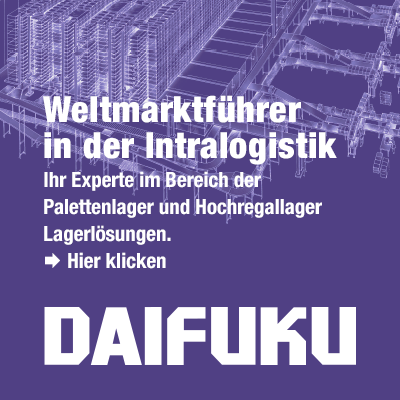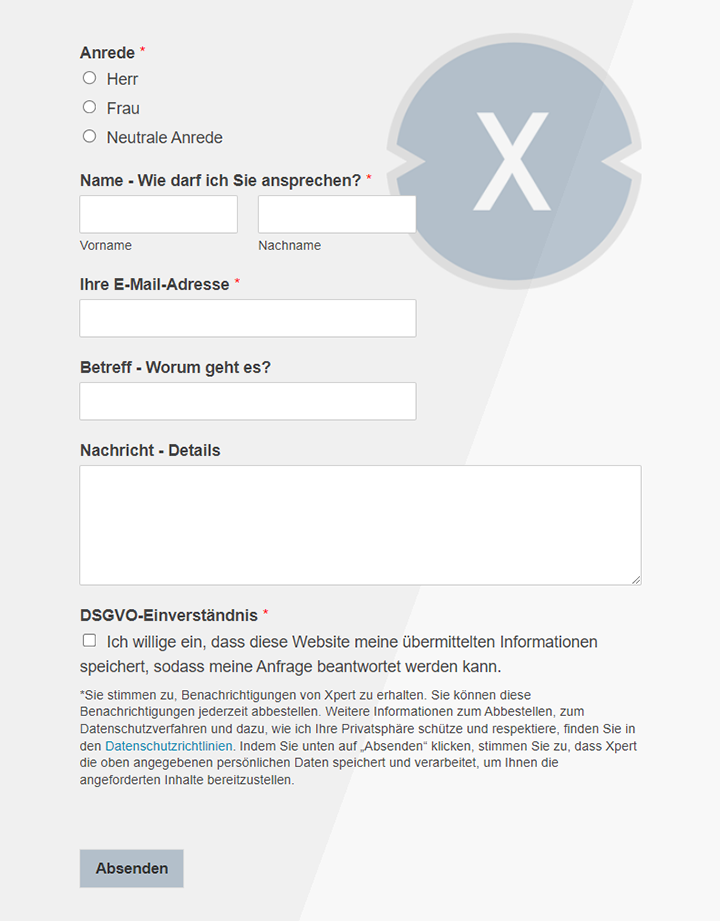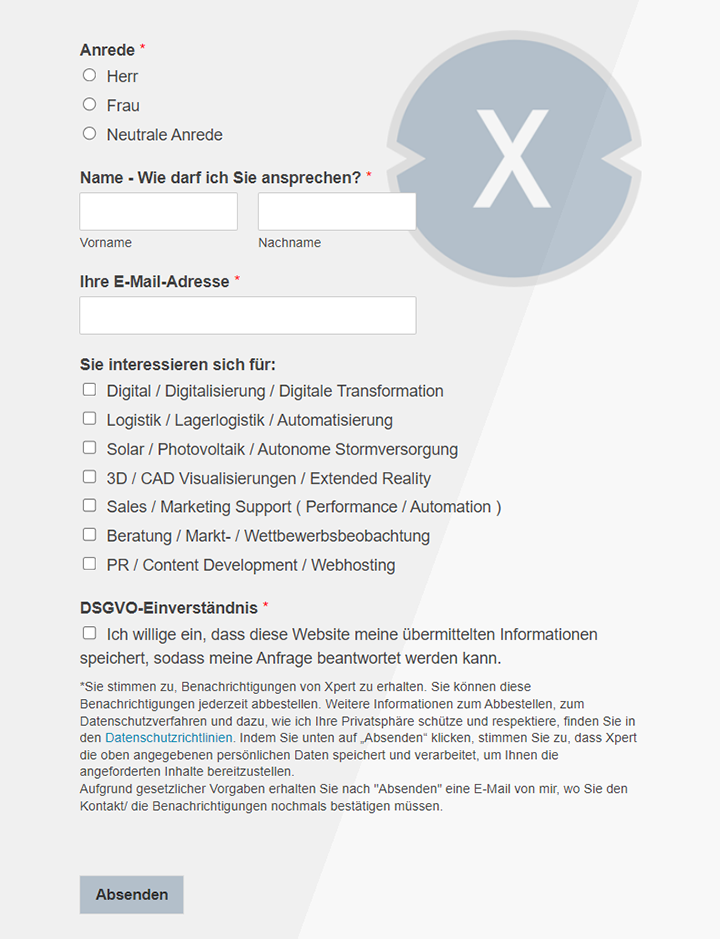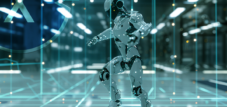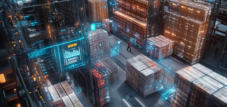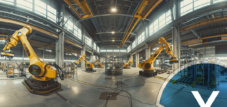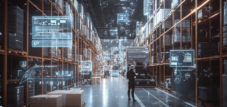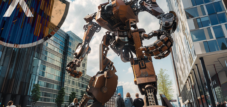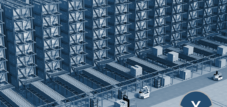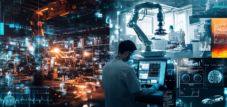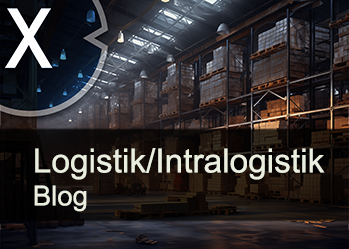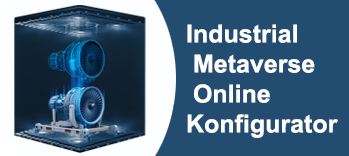Efficiency racingaissance of buffer warehouse with AI and robotics in the automation to stabilize the regional economy
Xpert pre-release
Language selection 📢
Published on: January 24, 2025 / update from: January 24, 2025 - Author: Konrad Wolfenstein

Efficiency racingaissance of buffer warehouse with AI and robotics in the automation to stabilize the regional economy-Image: Xpert.digital
With AI and robotics for top logistics: The Renaissance of the buffer camp begins
Automated buffer warehouse: AI as the key to regional economic stabilization
The integration of artificial intelligence (AI) and robotics into automated buffer camp leads to a real efficiency Renaissance in logistics, which has far-reaching positive effects on the regional economy.
AI and robotics revolutionize warehousing
Modern warehouses are increasingly relying on AI-controlled robot systems to optimize processes and significantly increase efficiency. Autonomous mobile robots (AMRS) take on tasks such as picking, transport and packaging of goods. These systems work around the clock, which leads to a significant increase in productivity.
Core advantages of automation
- Increased efficiency and productivity by reducing waiting times and optimizing transports
- Increased accuracy and reliability, which leads to fewer mistakes and higher customer satisfaction
- Cost reduction by minimizing manual interventions
- Improved scalability to react flexibly to fluctuating requirements
AI as the driver of process optimization
AI algorithms analyze huge amounts of data in real time in order to recognize patterns and continuously improve processes. This enables:
- Precise predictions for existence, which prevents excess stands and bottlenecks
- Dynamic route planning for AMRS based on current inventory and priorities
- Automated quality control for the detection of incorrect products
Effects on the regional economy
The implementation of these technologies has far -reaching positive effects on the local economic structure:
- Strengthening competitiveness: Companies that invest in AI and robotics can significantly increase their productivity and assert themselves in global competition.
- Creation of new jobs: While some routine tasks are automated, new, highly qualified positions are created in areas such as AI development and robot maintenance.
- Promotion of innovations: The cooperation between research institutions and regional companies is driving technological innovations.
- Efficiency increase in the supply chain: Optimized warehouse processes lead to faster delivery times and higher customer satisfaction, which strengthens the entire regional economy.
- Sustainability: AI-controlled systems contribute to resource conservation and waste reduction, which promotes the region's ecological sustainability.
Challenges and solutions
The implementation of AI and robotics in storage systems also brings challenges:
- High initial investments: Funding programs such as the “Ki-Regio” project at the University of Würzburg support SMEs in the introduction of AI technologies.
- Legal framework: Real laboratories like in Baden-Württemberg help companies to implement the new EU regulations for AI and machine regulations.
- Qualification of employees: Training programs and working with universities prepare workers for new requirements.
Future prospects
The continuous further development of AI and robotics promises further innovations:
- More advanced robot systems with increased flexibility and autonomy
- Extended AI skills for even more precise predictions and analyzes
- Increased human-robot collaboration through the use of cobots
These developments will further increase the efficiency and competitiveness of regional companies and thus make an important contribution to the stabilization and growth of the local economy.
Based on the current trends and forecasts for 2025, several promising developments are emerging in warehouse automation:
Advanced AI and robotics
More intelligent robot
Robots become more flexible and adaptable by AI integration. You can take on more complex tasks such as recognizing and handling different objects. These “smarter” robots independently optimize their work processes through machine learning and adapt to changes in the warehouse dynamically.
Collaborative robotics (Cobots)
Cooperation between humans and robots will intensify. Cobots enable flexible and human -centered automation by working page by side and supporting them in various tasks.
AI-controlled optimization
Predictive analytics
AI systems are increasingly used for forward-looking maintenance, forecasts and process optimization. You analyze large amounts of data in real time to predict potential disorders and proactively make adjustments.
Dynamic route planning
AI algorithms optimize the movements of autonomous transport systems in the warehouse, which leads to more efficient processes and shorter throughput times.
Advanced automation
Autonomous Mobile Robots (AMR)
The use of AMRS for goods transport and picking will spread further. These systems navigate through the warehouse independently and adapt their routes dynamically.
Automated storage systems
Advanced automated storage and picking systems are increasingly used to increase the storage capacity and increase efficiency.
Integration of IoT and real-time monitoring
Sensors and IoT devices enable comprehensive real-time monitoring of inventory and processes. This improves transparency and enables faster reactions to changes.
sustainability
Sustainable solutions such as energy -efficient automation systems and environmentally friendly packaging solutions gain in importance in order to reduce the ecological footprint of camps.
These developments promise a future in which camps can operate more efficiently, more flexible and sustainable. The integration of these technologies will enable companies to react better to the increasing requirements of e-commerce and the changing customer expectations.
Xpert partner in warehouse planning and construction
Buffer warehouse newly thought: How technologies promote growth and efficiency - and background analysis
When robotics and AI conquer the warehouse: the engine for regional economic growth
The modern logistics landscape is located in the middle of a profound change, which is powered by the integration of artificial intelligence (AI) and robotics into automated buffer bearings. This development, which can certainly be described as an efficiency Renaissance, has the potential to fundamentally transform and stabilize the regional economy. We see how outdated, manual processes are increasingly replaced by intelligent, automated systems, which leads to a significant increase in efficiency, precision and flexibility.
The revolution of warehousing by AI and robotics
Traditional warehousing, shaped by manual work and high error rates, gives way to a new era in which AI and robotics are the main players. Modern warehouses are increasingly relying on AI-controlled robot systems to optimize processes and maximize productivity. Autonomous mobile robots (AMRS) take on a variety of tasks, from picking and transport to the packaging and sorting of goods. These systems often work around the clock, without the fatigue symptoms of human employees, which leads to an unprecedented increase in productivity.
The introduction of these technologies is not only a technical progress, but also a strategic realignment of logistics. Due to the automation of critical processes, warehouses become dynamic nodes in the supply chain, which are able to react quickly and flexibly to changing requirements. It is no longer just about storing goods, but also about managing them intelligently and optimally distributing them.
Core advantages of automation in buffer camps
The advantages of automation by AI and robotics are diverse and substantial:
Increasing efficiency and productivity
The automation of transport and picking processes minimizes waiting times and the lead times are drastically shortened. Intelligent algorithms optimize the routes of the AMRS, which avoids unnecessary paths and the movement of the goods in the warehouse are made more efficient. This leads to a significant increase in the envelope speed and better use of the storage capacity.
Increasing accuracy and reliability
Automated systems minimize human errors in picking and inventory, which leads to a reduction in wrong stocks and false deliveries. This in turn increases customer satisfaction and strengthens confidence in the supply chain. The precise control of the goods movements reduces the risk of damage and losses, which has a positive effect on the company's profitability.
Reduction of operating costs
Automation reduces manual interventions and the associated costs. The use of robots and AI systems can lead to considerable savings on personnel costs, especially in areas where serious physical work used to be carried out. In addition, the energy costs are reduced by optimizing the warehouse processes.
Improvement of scalability and flexibility
Automated storage systems are more flexible and can better adapt to seasonal fluctuations or short -term changes in demand. Companies can expand their storage capacity quickly and efficiently without having to carry out great restructuring. This is particularly important in dynamic markets in which flexibility is a crucial competitive advantage.
Improvement of working conditions
By automating repetitive and physically exhausting tasks, employees are released from these stress. You can concentrate on more demanding and creative tasks that better use your specialist knowledge and skills. This leads to greater job satisfaction and a better binding of the employees to the company.
Increasing security
The automation of dangerous tasks reduces work accidents and a safe working environment is created. Robots can take on tasks that would be risky for humans, e.g. B. lifting heavy loads or working in confusing warehouse areas.
AI as a driving force of process optimization
The role of artificial intelligence goes far beyond the mere control of robots. AI algorithms analyze huge amounts of data in real time to recognize patterns, make predictions and continuously optimize processes. This enables:
Precise inventory planning
AI systems can analyze historical sales data, seasonal trends and other relevant factors in order to predict the future needs of stocks with high accuracy. This prevents excess stands that lead to unnecessary storage costs and bottlenecks that can affect the ability to deliver. By optimizing the inventory, companies can reduce their capital ties and increase their liquidity.
Dynamic route planning
AI algorithms plan the optimal routes for AMRS based on the current inventory, the priority of the orders and other relevant factors. This makes the movement of the robots more efficient in the warehouse and shorten the lead times. The dynamic adjustment of the routes enables unexpected events, such as: B. a sudden increase in demand to react flexibly.
Automated quality control
AI-controlled image labeling systems can check products for errors or damage before they are sent. This minimizes the risk of returns and increases customer satisfaction. The automation of quality control helps to reduce the production costs and increase the efficiency of the processes.
Predictive maintenance
AI can analyze the behavior of machines and robots to predict potential failures and plan maintenance work in good time. This minimizes downtime and increases the availability of the systems. The forward -looking maintenance helps to extend the lifespan of the systems and reduce the operating costs.
Optimization of storage space use
AI algorithms can optimize the placement of the goods in the warehouse in order to use the storage capacity in the best possible way and to minimize the picking trails. The intelligent warehouse management helps to increase the efficiency of the entire warehouse.
Effects on the regional economy
The implementation of AI and robotics in buffer camps has far -reaching effects on the regional economic structure and can start a positive cycle of innovation, competitiveness and workplace acquisition:
Strengthening competitiveness
Companies that invest in AI and robotics can significantly increase their productivity and efficiency. This enables you to survive in global competition, to open up new markets and to strengthen your market position. Improved competitiveness leads to growth, new investments and the creation of new jobs in the region.
Creation of new, highly qualified jobs
While some routine tasks are automated, new, highly qualified positions are created in areas such as AI development, robotics, data analysis, maintenance and management of automated systems. These jobs offer attractive career opportunities and contribute to skilled workers in the region. The transition to a more automated economy requires adaptation of the educational and further education systems to prepare the workforce for the new requirements.
Promotion of innovations and research
The cooperation between research institutions and regional companies is driving technological innovations. With the exchange of knowledge and the joint development of solutions, new technologies can be put into practice more quickly. The regional economy benefits from the innovative strength of universities and research institutes, which in turn benefit from the practical expertise of companies.
Efficiency increase in the supply chain
Optimized warehouse processes lead to faster delivery times, shorter throughput times and higher customer satisfaction. This has a positive effect on the entire supply chain and strengthens the regional economy as a whole. Companies that benefit from an efficient supply chain can reduce their costs, increase their competitiveness and better use their customers.
sustainability
AI-controlled systems can contribute to resource conservation, waste reduction and energy efficiency. By optimizing the warehouse processes, companies can reduce their ecological footprint and contribute to the sustainability of the region. The use of energy -efficient robots and automated systems can significantly reduce energy consumption in warehouses.
Attractiveness for investors
Regions with a high density of companies that invest in AI and robotics are becoming more attractive for investors. The presence of innovative companies and a well -trained workforce can lead to further investments and the region's economic growth. A dynamic and future -oriented economy is a magnet for capital and specialists.
Strengthening the regional economic cycle
The introduction of AI and robotics in buffer camps can lead to strengthening the regional economic cycle. If regional companies become more competitive and efficient, you can better stop your products and services and thus contribute to the economic development of your region.
Challenges and solutions
The implementation of AI and robotics in storage systems is not without challenges. There are some hurdles that need to be overcome in order to be able to fully exploit the advantages of these technologies:
High initial investment
The introduction of AI and robotics requires considerable investments in hardware and software, training courses and the integration of the new technologies into existing systems. Many small and medium -sized companies (SMEs) shy away from these investments because they cannot bear the associated financial risk. Here, funding programs and financial support from state or regional initiatives are required to facilitate access to these technologies. Projects such as the “Ki-Regio” of the University of Würzburg provide valuable support here by helping SMEs to introduce AI technologies.
Legal framework
The development of AI and robotics is progressing quickly, and the legal framework often lags behind. It is important to create clear and uniform rules for the use of AI and robotics, especially with regard to liability, data protection and security. Real laboratories like in Baden-Württemberg help companies to implement the new EU regulations for AI and machine regulations.
Qualification of employees
The introduction of AI and robotics requires new skills and skills from the employees. It is important to offer training programs and further training opportunities in order to prepare the workers for the new requirements. The cooperation between universities and companies is crucial to train employees in the areas of AI, robotics and data analysis.
Acceptance and trust
The introduction of new technologies can cause fears of job loss or changes in their work processes among employees. It is important to actively involve employees in the change process, to take their concerns seriously and to clarify them about the advantages of the new technologies. Open communication and transparent management can strengthen employees' trust in the new technologies.
Security
The use of robots and automated systems requires a lot of attention to security questions. It is important to ensure that the systems work reliably and do not pose any danger to people. Comprehensive security concepts must be developed that minimize potential risks.
Future prospects and outlook on 2025
The continuous further development of AI and robotics promises further innovations and improvements in warehouse automation. Based on current trends and forecasts for 2025, the following promising developments are emerging:
More advanced robot systems
Robots become more flexible, intelligent and adaptable. You will be able to take on more complex tasks, to recognize and use different objects and to optimize your work processes independently. The integration of artificial intelligence into robots will lead to “smarter” robots that constantly improve their performance through machine learning.
Collaborative robotics (Cobots)
Cooperation between humans and robots will intensify. Cobots will not replace human employees, but will support them in their tasks. You will be able to work side by side with the employees, take heavy and repetitive tasks and increase their efficiency.
Extended AI skills
The AI systems will deliver even more precise predictions and analyzes. You will be able to identify complex patterns in large amounts of data, plan forward -looking maintenance work and optimize dynamic routes for autonomous transport systems. The development of ever better AI algorithms will further increase the efficiency of the warehouse processes.
Real-time monitoring and IoT
Sensors and IoT devices will enable comprehensive real-time monitoring of inventory, processes and systems. This will improve transparency, enable faster reactions to changes and lead to better control of the warehouse processes. The integration of IoT devices into warehouses will lead to the networking of all elements of the warehouse.
Autonomous Mobile Robots (AMRs)
The use of AMRS for goods transport, picking and other tasks will spread further. These systems will be able to navigate through the warehouse independently, to dynamically adapt their routes and to react to changes in real time. AMRs will play a crucial role in automation of intralogistics.
Automated storage systems
Advanced automated storage and picking systems are increasingly used to increase the storage capacity, increase efficiency and optimally use the storage space. These systems will be able to store and manage large amounts of goods, to shorten the throughput times and reduce the costs.
sustainability
Sustainable solutions are becoming increasingly important. Energy -efficient automation systems, environmentally friendly packaging solutions and a resource -saving handling of materials will become more important. The integration of sustainability aspects into warehouse logistics will lead to a reduction in the ecological footprint of warehouses.
Efficiency revolution in buffer camps
The efficiency revolution in buffer camps by AI and robotics is not only a technical progress, but also a crucial step towards stabilization and growth of the regional economy. The developments described will enable companies to become more competitive, reduce their costs, increase their efficiency and better use their customers. The integration of these technologies will lead to sustainable development that creates jobs, promotes innovations and increases the attractiveness of the region for investors. The successful transformation of warehouse logistics will thus become a decisive factor for future competitiveness and the prosperity of the regional economy.
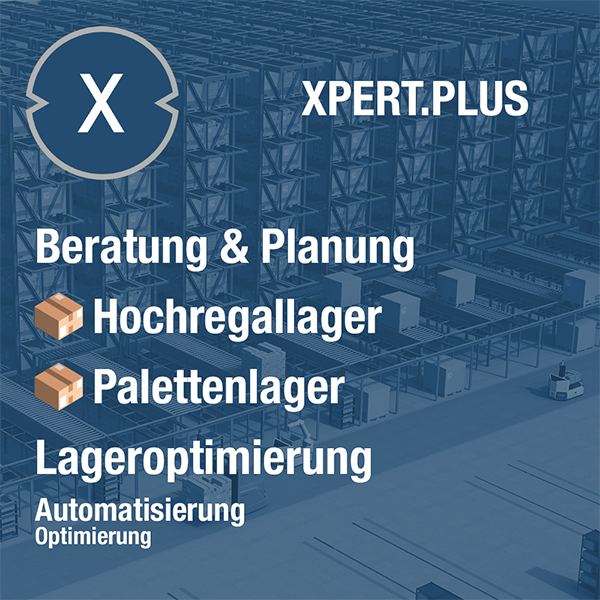
Xpert.Plus warehouse optimization - high-bay warehouses such as pallet warehouses consulting and planning
We are there for you - advice - planning - implementation - project management
☑️ SME support in strategy, consulting, planning and implementation
☑️ Creation or realignment of the digital strategy and digitalization
☑️ Expansion and optimization of international sales processes
☑️ Global & Digital B2B trading platforms
☑️ Pioneer Business Development
I would be happy to serve as your personal advisor.
You can contact me by filling out the contact form below or simply call me on +49 89 89 674 804 (Munich) .
I'm looking forward to our joint project.
Xpert.Digital - Konrad Wolfenstein
Xpert.Digital is a hub for industry with a focus on digitalization, mechanical engineering, logistics/intralogistics and photovoltaics.
With our 360° business development solution, we support well-known companies from new business to after sales.
Market intelligence, smarketing, marketing automation, content development, PR, mail campaigns, personalized social media and lead nurturing are part of our digital tools.
You can find out more at: www.xpert.digital - www.xpert.solar - www.xpert.plus



